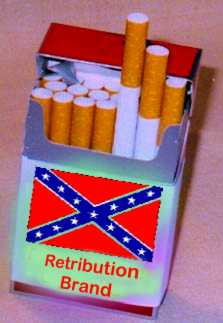Proposal to Ban Tobacco Billboards Within 1,000 Feet
of Public Schools, Playgrounds, and Parks
(June 1998)
Tobacco ads are inherently fraudulent, and fail to warn that tobacco leads to crime, 90% of criminals are smokers.
A. Tobacco ads fraulently fail to warn that cigarettes' toxic chemicals impair impulse and ethical controls. Cigarettes are the delivery agent for nicotine, the dangerous gateway (starter) drug on which children are first hooked (average age 12). Alcohol follows, average age 12.6; then marijuana, average age 14. Sources:
the Department of Health, Education and Welfare (HEW) book, Research on Smoking Behavior, Research Monograph 17, page vi; Fleming, et al., "The Role of Cigarettes in The Initiation And Progression Of Early Substance Use," 14 Addictive Behaviors 261-272 (1989); and the Department of Health and Human Services book, Preventing Tobacco Use Among Young People: A Report of the Surgeon General (1994). Page 10 warns that "Illegal sales of tobacco products are common."
B. Once the foregoing process occurs, tobacco's role in crime results. This role has been cited many times by law enforcement officials, judges, and doctors since the Auburn Report (1854), e.g., by Jackson, 1854; Hodgkin, 1857; Ellis, 1901; Lindsay, 1914; Torrance, 1916; Brum, 1924; Danis, 1925; Healy and Bonner, 1926; Crane, Dawson, Pollock, and Shaw, 1931; Wood, 1944, etc.
"Nowhere is the practice of smoking more imbedded than in the nation's prisons and jails, where the proportion of smokers to non-smokers is many times higher than that of society in general." Doughty v Board, 731 F Supp 423, 424 (D Col, 1989).As smoking causes abulia, acalculia, and anosognosia, impairing impulse and ethical controls, most crime is committed by smokers.
"Nationwide, the [ratio] of smokers [to non-smokers] in prisons is 90 percent." McKinney v Anderson, 924 F2d 1500, 1507 n 21 (CA 9, 1991) [affirmed and remanded, 509 US 25 (1993)].
C. Due to advertising and selective locationing, minorities are targeted into the drug sequence, as the most recent Surgeon General Report discusses. So it is mostly black smokers in prison. We need to stop this discriminatory process.
Don't Want Children to Smoke
| The article, "Volunteer Vice Squad," in Time magazine, 23 April 1990, by Janice Castro, says, e.g., "The executives in the television commercial are grim. 'We need more smokers!' growls the tough-talking boss of a tobacco firm. 'Every day 2,000 Americans stop smoking. And another 1,100 also quit. Actually, technically, they die. That means that this business needs 3,000 fresh new volunteers every day. So forget about all of that cancer, heart. . . .'" The pushers know, intend, what they are doing. |
A. It is illegal to provide people the means—e.g., a deleterious substance—to injure or kill themselves. People v Carmichael, 5 Mich 10; 71 Am Dec 769 (1858); People v Kevorkian, 447 Mich 436, 494-6; 527 NW2d 714, 738-9 (1994). It is illegal even if death is slow, takes years. People v Stevenson, 416 Mich 383; 331 NW2d 143, 145-6 (1982).
B. Tobacco ads fraudulently fail to warn that cigarette emissions violate federal law, i.e., 29 CFR § 1910.1000. The Department of Health, Education and Welfare book, Smoking and Health: Report of the Advisory Committee to the Surgeon General of the Public Health Service, PHS Pub 1103, Table 4, p 60 (1964), lists examples of deleterious emissions violating the federal rule:
| Cigarette Chemical | Emission Level | |
| acetaldehyde | 3,200 ppm | 200.0 ppm |
| acrolein | 150 ppm | 0.5 ppm |
| ammonia | 300 ppm | 150.0 ppm |
| carbon monoxide | 42,000 ppm | 100.0 ppm |
| formaldehyde | 30 ppm | 5.0 ppm |
| hydrogen cyanide | 1,600 ppm | 10.0 ppm |
| hydrogen sulfide | 40 ppm | 20.0 ppm |
| methyl chloride | 1,200 ppm | 100.0 ppm |
| nitrogen dioxide | 250 ppm | 5.0 ppm |
and due to abulia, impairment of willpower, and self-defense, impulse and ethical controls--lay word is "addiction"--and due to anosognosia, lack of comprehension of their impairments, smokers cannot understand the danger that these numbers depict, in effect, going far above the chemicals' "speed limit.") |
C. Tobacco ads fraudulently solicit, aid, and abet, and are accessory to, violations of Michigan law MCL § 750.27, MSA § 28.216, which bans deleterious and adulterated cigarettes. All cigarettes are inherently deleterious. The warning label admits it. Grusendorf v City of Oklahoma City, 816 F2d 539, 543 (CA 10, 1987). The Department of Health and Human Services book, Reducing the Health Consequences of Smoking: 25 Years of Progress: a Report of the Surgeon General, Publication CDC 89-8411, Table 7, pp 86-87 (1989), lists examples of deleterious ingredients including:
| acetaldehyde (1.4+ mg) | arsenic (500+ ng) | benzo(a)pyrene (.1+ ng) |
| cadmium (1,300+ ng) | crotonaldehyde (.2+ g) | chromium (1,000+ ng) |
| ethylcarbamate 310+ ng) | formaldehyde (1.6+ g) | hydrazine (14+ ng) |
| nickel (2,000+ ng) | lead (8+ g) | radioactive polonium (.2+ Pci). |
Tennessee in 1897 saw the danger, and banned cigarettes. The 1897 Tennessee cigarette ban was challenged, and upheld in court, Austin v State, 101 Tenn 563, 566-7; 48 SW 305, 306; 70 Am St Rep 703 (1898) aff'd 179 US 343 (1900). Michigan saw this, and passed its cigarette ban soon thereafter, in 1909. Many people still alive then remembered that Confederates--the source of tobacco--had fought for the right to torture and kill. That right, which underlay slavery, had been repeatedly upheld in Southern courts, e.g., Commonwealth v Turner, 26 Va 678 (1827); State v Mann, 13 NC 263 (1829); Neal v Farmer, 9 Ga 555 (1851); and Commonwealth v Souther, 48 Va 673 (1851). So in 1909, there was prudent suspicion that they wanted revenge, and would manipulate and flavor the product so as to torture and poison Northerners. There was evidence of poisoning.

Tobacco ads fraudulently fail to warn that cigarettes have long been adulterated, flavored, with coumarin, rat poison, from trilisa odoratissima plants. "[I]t is largely used as an adulterant of smoking tobacco . . . [for its intoxicating, addicting effect]. Hence . . . cigarette-smoking . . . is assuming the proportions of a great national evil." Laurence Johnson, M.D., A Manual of the Medical Botany of North America (NY: William Wood & Co, 1884), pp 170-1. The 1897 Tennessee law upheld in Austin v State, supra, was thereafter passed.
"It] has been used commercially for many years--mainly in cigarettes . . . harvest of [it] is expanding . . . The composition of one flavoring extract that includes [it] was patented in 1961. . . . About two million pounds of cured plants are harvested annually. . . . Because [it] is a perennial and the roots are not harvested, maintaining populations is not a problem. A decrease in plant populations has not been noted." Source: Krochmal, Trilisa odoratissima, 23 Econ Bot 185-6 (1969).
"Leaves of [the plant] . . . are used in the tobacco industry, particularly in cigarette mixtures. . . . It appears that the . . . constituent most desired by the tobacco industry is coumarin." Source: Haskins, et al., Coumarin in Trilisa odoratissima, 26 Econ Bot 44-8 (1972).
"Leaves used to flavor pipe and cigar tobacco and cigarettes . . . and as a moth repellant . . . may cause hemorrhage and liver damage." Source: James A. Duke, Handbook of Medicinal Herbs (Boca Raton, FL: CRC Press, 1985), p 491.
In one of the cigarette litigation cases, Mike Moore, Attorney General ex rel State of Mississippi v American Tobacco Co, et al, No 94-1429, Jeffrey Wigand, Ph.D., an ex-tobacco company scientist, admitted coumarin (rat poison) in tobacco. Flouting the above public domain data, tobacco company attorney Thomas Bezanson objected, not as untrue, but "on trade secret grounds." Such attorney concealment appears to be attorney misconduct, as a clear attempt to fraudulently conceal the fact of the data having long been published and in the public domain. The Wigand deposition is in Philip Hilts' book, Smoke Screen: The Truth Behind The Tobacco Industry Cover-Up (NY: Addison-Wesley Pub Co, 1996), pp 161-163.
A. Gosselin, Smith, Hodge, and Braddock, Clinical Toxicology of Commercial Products, 5th ed (Baltimore: Williams & Wilkins, 1984). Page II-4 lists toxicity levels of 1-6 (1, "practically non-toxic"; 4, "very toxic"; 6, "super-toxic"). Nicotine, item 772, pages II-237 and III-311-4 is rated a 6; coumarin, page II-257, item 861, is a 4.
B. Robert Dreisbach and William Robertson, Handbook of Poisoning: Prevention, Diagnosis and Treatment, 12th ed (Norwalk, CT: Appleton & Lange, 1983 and 1987). Pages 35 and 259-263 cover carbon monoxide poisoning; pages 130-2, tobacco and nicotine; pages 385-7, anticoagulants, e.g., coumarin and warfarin.
C. Sondra Goodman, Director, Household Hazardous Waste Project, HHWP's Guide to Hazardous Products Around the Home, 2d ed (Springfield, MO: Southwest Mo St Univ Press, 1989). Page 99 covers poisoning by carbon monoxide, of which cigarettes emit 42,000 ppm , exceeding the 29 CFR § 1910.1000 average safe limit of 35 ppm).
D. Jay Arena and Richard Drew, Poisoning, 5th ed (Springfield, IL: Charles C. Thomas Pub, 1986). Pages 216-217 cover nicotine; pp 308-312, carbon monoxide; p 999, which lists coumarin, says, ominously, "see Warfarin," p 1007.
Due to cigarettes' deleteriousness, "Over 37 million people (one of every six Americans alive today) will die from cigarette smoking years before they otherwise would," see U.S. Department of Health, Education, and Welfare book, Research on Smoking Behavior, Research Monograph 17, DHEW Publication ADM 78-581, page v (Dec 1977). Such deaths are "natural and probable consequences," a term defined in Black's Law Dictionary, 6th ed (St. Paul: West Pub Co, 1990), page 1026. Deaths from cigarettes' deleteriousness occur so frequently as to be expected to happen again and again, hence meet the definition.
 VII. Michigan Leadership
VII. Michigan Leadership
 |
Our deleterious cigarette ban MCL § 750.27, MSA § 28.216, follows the wise nineteenth century concept of criminalizing fraudulent sales, snake-oil sales, etc., not the buying. The concept was that criminalizing buying and use makes too many criminals, promotes disrespect for law, and punishes the victim of the fraudulent sale. This is especially true with children, below the age of maturity and consent to even make contract decisions. We criminalize leaving one's refrigerator outside with the lock on ( MCL § 750.493d, MSA § 28.761(4)), not the unsuspecting children who fall prey to it. By banning the gateway drug, not a post-gateway drug such as alcohol, MCL § 750.27, MSA § 28.216, avoids the error of Prohibition, and puts personal responsibility on those with most knowledge of the contraband substance (manufacturers and sellers), not on unwary consumers, often children. Michigan's well-reasoned law is an example for the nation.
Support the proposal, indeed ban all cigarette billboards, as they are inherently fraudulent ads for an illegal product.

RELATED INFORMATION
Governor John Engler and his staff have been supportive and are trying to halt cigarette smuggling, issuing five memoranda on the subject.
| Exec Order 1992-3 | Law Support Letter # 1 | Anti-Cigarette Smuggling Finding | Law Support Letter # 2 | Governor's Overview |
| For State Billboard Ban | For Detroit's Billboard Ban | Increase Penalty For Cigarette Selling |
| For Return to The Top of This Page |
This site is sponsored as a public service by
Copyright © 1998 TCPG
The Crime Prevention Group